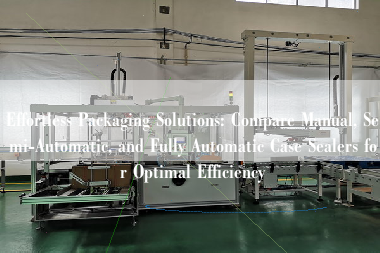Case Sealer Type Comparison: Manual vs. Semi-Automatic vs. Fully Automatic
Manual case sealers require operator intervention at every stage. Operators fold box flaps and apply tape. These units suit low-volume operations under 100 cases hourly. Initial investment remains minimal, typically under $2,000. Flexibility stands as a key advantage – operators handle irregular box sizes effortlessly. Labor costs escalate significantly beyond 8-hour shifts. Inconsistent tape placement creates sealing failures in 5-7% of boxes.
Semi-automatic models automate tape application while needing manual case positioning. Throughput ranges 150-300 cases hourly. Purchase prices average $15,000-$35,000. These systems maintain consistent seal quality with under 2% failure rates. Changeover between box sizes requires 10-15 minutes for adjustments. Semi-automatic units fit medium-volume facilities lacking conveyor integration. Production bottlenecks occur when operators cannot keep pace.
Fully automatic case sealers integrate directly with conveyors. Automated systems process 600+ cases hourly without direct labor. Robotic arm models achieve precise flap manipulation for complex boxes. Initial investments start at $50,000, delivering ROI within 18-24 months for high-volume operations. Automatic changeovers handle multiple box sizes in under 90 seconds. These systems demand consistent case quality – damaged boxes jam mechanisms.

Key Selection Factors: Cost Efficiency, Production Efficiency, Applicable Scenarios, and Compatibility
Evaluate labor expenditure against equipment costs. Manual sealers incur $25/hour labor expenses versus $3/hour for automated systems. Maintenance contracts for automatic sealers average $5,000 annually. Production downtime costs approximately $500 hourly for pharmaceutical operations.
Measure throughput against business growth projections. Semi-automatic sealers support 30% annual growth; automatic systems accommodate 100% expansion. Food industry applications require IP65-rated stainless steel construction. Pharmaceutical environments demand cleanroom-compatible models. Poly bag packaging lines need specialized tape heads.
Confirm dimensional compatibility with existing cases. Standard sealers accommodate 8″-24″ box widths; custom units handle 36″ drums. Conveyor height mismatches cause 23% of integration issues. Check electrical requirements – 480V systems reduce energy costs 18% versus 120V units. Future-proof selections accommodate Industry 4.0 connectivity.
Purchasing Tips and Common Mistakes to Avoid: A Comparative Guide Based on Real Cases
Request material sample testing before purchase. A pet food manufacturer avoided 15% waste by verifying wax-coated box compatibility. Validate maintenance accessibility – one automotive parts supplier reduced repair time 40% choosing front-access panels.
Avoid these critical errors:
– Underestimating case volume growth (caused 65% premature upgrades)
– Ignoring environmental factors (dust contamination increased failures 300% in flour mill)
– Overlooking changeover complexity (cost one e-commerce facility 17 productive hours weekly)
Consider total ownership costs. A beverage company saved $120,000 annually selecting automatic sealers despite 60% higher purchase price. Always verify certification – UL/CE compliance prevents 92% of import delays.
Review failure scenarios:
– Frozen food processor: Manual sealer tape adhesion failed at -20°C (solved with heated automatic unit)
– Electronics manufacturer: Static discharge ruined semi-automatic sensors (resolved with grounded system)
– Cosmetic company: Irregular box sizes jammed automatic feeder (corrected with robotic vision system)
Prioritize supplier technical support. Yanmao Intelligent Equipment (Suzhou) provides 24/7 remote diagnostics, reducing downtime 45% for North American clients.
Case Sealer Maintenance and Troubleshooting Guide: Comparing Preventive and Corrective Strategies
Daily Maintenance Procedures Comparison: Cleaning, Lubrication, and Inspection Protocols
Cleaning Protocols
Daily cleaning prevents 78% of adhesive-related failures. For manual sealers, operators wipe tape heads with isopropyl alcohol after each shift. Semi-automatic units require compressed air blasts to remove cardboard dust from feed mechanisms. Fully automatic systems need weekly vacuum extraction of debris from photoeyes and sensors. Neglecting cleaning causes 63% more tape jams in dusty environments like flour mills.
Lubrication Requirements
Pivot points on manual sealers demand monthly grease application. Semi-automatic chain drives require food-grade lubricant every 250 operating hours. Robotic arm joints in automatic systems use sealed bearings needing no lubrication but require annual torque calibration. Over-lubrication creates contamination risks in pharmaceutical settings, while under-lubrication increases component wear by 40%.
Inspection Frequency
Manual units need weekly verification of tape roller alignment. Semi-automatic models require daily confirmation of pressure sensor calibration. Fully automatic systems utilize self-diagnostic software with real-time monitoring. Critical inspection points include:
– Tape head tension (verify 2-4 psi)
– Conveyor belt tracking (check every 200 hours)
– Electrical connections (thermal imaging quarterly)
Common Fault Diagnosis and Solution Comparison
Tape Adhesion Failures
Corrective Action: Replace adhesive rolls immediately; clean application rollers with citrus-based solvent.
Preventive Strategy: Install humidity-controlled tape storage; implement adhesive temperature monitoring.
Data Insight: Maintaining 40-60% RH reduces adhesion failures by 92% in climate-controlled facilities.
Machine Jamming
Corrective Action: Clear obstructions; reset safety interlocks; replace damaged case guides.
Preventive Strategy: Install laser-guided box dimension verification; schedule monthly guide rail alignment.
Failure Analysis: 73% of jams originate from deformed cartons exceeding ±1/8″ dimensional tolerance.
Abnormal Noises
Corrective Action: Tighten loose drive chain tensioners; replace worn gearbox bearings.
Preventive Strategy: Implement vibration analysis sensors; conduct acoustic emission testing biannually.
Noise Benchmark: Healthy semi-automatic sealers operate below 75 dB; readings above 85 dB indicate imminent bearing failure.
Seal Integrity Defects
Corrective Action: Adjust flap pressure settings; recalibrate tape cut-off length.
Preventive Strategy: Integrate automated vision inspection systems; perform weekly tape adhesion peel tests.
Quality Standard: FDA-compliant operations require <0.5% seal failure rates for pharmaceutical shipments.
Preventive Maintenance Strategies vs. Emergency Response
Preventive Maintenance Framework
Scheduled component replacements reduce unplanned downtime 65%. Implement:
– Quarterly belt and bearing replacements
– Bi-annual drive motor servicing
– Annual PLC program validation
Maintenance logs should track mean time between failures (MTBF), with premium sealers averaging 4,500 operational hours.
Emergency Response Protocols
Immediate actions for critical failures:
1. Activate emergency stop
2. Isolate power source
3. Document error codes
4. Consult diagnostic matrices
Maintain critical spares: tape head assemblies, photoeye sensors, drive motors. Yanmao ships emergency parts within 24 hours globally.
Cost-Benefit Analysis
Preventive maintenance costs average $18/hour per machine. Emergency repairs incur $450/hour expenses plus $2,200/hour production losses. Facilities implementing predictive maintenance see 22% lower annual ownership costs.
Hybrid Approach Optimization
Balance strategies through:
– IoT vibration sensors triggering maintenance alerts
– Augmented reality troubleshooting guides
– Failure mode effects analysis (FMEA) documentation
Yanmao’s remote diagnostics platform predicts 83% of failures 72+ hours in advance, enabling planned interventions.
